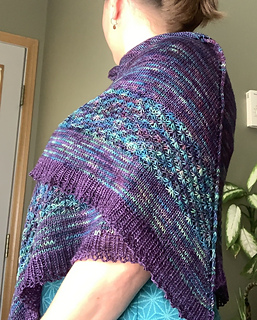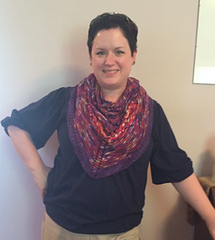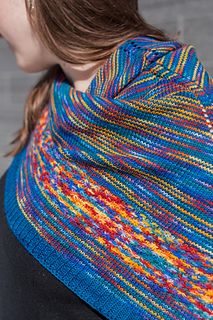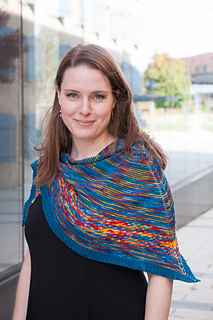patterns >  Anne Blayney's Ravelry Store
Anne Blayney's Ravelry Store
> Brightness and Contrast

Brightness and Contrast
At some point in our knitting lives, most of us encounter That Skein. That Skein is hand-dyed, richly multi-hued, and a perfect masterpiece in its own right. That Skein is something we covet, something we can’t resist purchasing, something we pet and stroke… and yet it languishes in stashdom. The problem with That Skein is that we can’t quite match the genius of its dyework to a pattern that does justice to its marvelous colours. Sometimes, That Skein turns muddy when knit up; sometimes it pools or flashes in unwanted ways. Sometimes it just refuses to let us knit it until it knows we can do full justice to its dyer’s art.
Brightness and Contrast is designed to take That Skein and, with a solid or tonal helper yarn, really let it sing.
This is an approachable shawl, with clever-but-easily-worked single-row stripes that keep the shades in That Skein from muddying each other. There is a contrasting band of a textural stitch that looks complex but is easily memorized, and which pulls That Skein into dimensional bursts of glowing colour. While the techniques used in Brightness and Contrast are simple, the result is anything but boring!
Yarn requirements:
1 skein multi-coloured fingering-weight yarn
- Sample uses indigodragonfly CaribouBaa in colourway Beige (100% superwash merino, 4-ply, 398 m/435 yds to 100 gr)
1 skein solid-coloured fingering-weight yarn
- Sample uses indigodragonfly CaribouBaa in colourway You Punched the Highlights Out of Her Hair! (Scott Pilgrim vs. the World) (100% superwash merino, 4-ply, 398 m/435 yds to 100 gr)
Notes on Yarn Substitutions and Sizing:
Gauge is not critically important in a non-fitted accessory, but you want to create a finished fabric with flow and drape. Choose a needle size appropriate to your yarn, and in general, larger than the needle size recommended on the tag.
This pattern requires a multi-coloured yarn and a solid/tonal yarn that will work well together. Ideally, you will be able to get both yarns from the same dyer in the same yarn base, as with the indigodragonfly offerings used here. However, if you need to find a solid/tonal yarn to work with your multicoloured yarn, pay close attention to the yarn weight and structure, and to its materials, to try to find a second yarn that will work similarly.
This pattern could be worked with any weight of yarn, from laceweight to bulky, but yarns in fingering weight are staples of many hand-dyers, and they knit up into a comfortable weight of shawl. Do note that any yarn substitution may affect the yardage required for the pattern.
I’ve had several inquiries about the shawl pin shown with the shawl. I highly recommend these pins, and I own multiple versions! Find them on Etsy.
1776 projects
stashed
3570 times
- First published: October 2014
- Page created: October 29, 2014
- Last updated: April 22, 2021 …
- visits in the last 24 hours
- visitors right now























